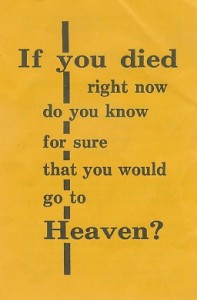(this is a continuation of Creation Museum Part 4 )
 To clean up the shenanigans that occurred after God screwed things up in the Garden of Eden, the story says that God decided to wipe the Earth clean except for Noah, his wife, his sons, and their wives… and of course two (or seven) of every “kind” of animal (not counting sea animals).
To clean up the shenanigans that occurred after God screwed things up in the Garden of Eden, the story says that God decided to wipe the Earth clean except for Noah, his wife, his sons, and their wives… and of course two (or seven) of every “kind” of animal (not counting sea animals).
The Creation Museum has quite a bit about the ark and there’s a definite dividing line that separates the two main parts. The first part shows how the ark could have been created and has incredibly detailed dioramas of different stages of the ark’s progress. The second part contains all the tortured, pseudo-scientific rationale for the flood’s being real. The first part was fun (if unbelievable). The second part was painful.
 The room pictured above showed animatronic workers helping build the ark… and complaining about all the hard work. The plaque on the scaffolding explains that this section represents only about one percent of the size of the “actual” ark. The design of the ark is explained in one of the Creation Museum videos and is definitely not the stereotypical “box” form that is frequently shown.
The room pictured above showed animatronic workers helping build the ark… and complaining about all the hard work. The plaque on the scaffolding explains that this section represents only about one percent of the size of the “actual” ark. The design of the ark is explained in one of the Creation Museum videos and is definitely not the stereotypical “box” form that is frequently shown.
 Another sign explains how the ark is a technological marvel, the building of which was completely independent of any financial concerns… and the hull could have been made “incredibly strong using ordinary wood and simple tools.”
Another sign explains how the ark is a technological marvel, the building of which was completely independent of any financial concerns… and the hull could have been made “incredibly strong using ordinary wood and simple tools.”
 A smaller model shows another cross-sectioned segment of the ark, clearly showing multiple decks. It’s actually a little bigger than what God commanded Noah to build, but it’s an impressive model nonetheless. Great pains are taken to explain how the ark could have been built large enough to hold all the animals, sturdy enough to withstand all the raging floodwaters, and technologically advanced enough that it wouldn’t fall apart or tip over after floating aimlessly on the water for about a year… even though it was built by folks who weren’t shipwrights.
A smaller model shows another cross-sectioned segment of the ark, clearly showing multiple decks. It’s actually a little bigger than what God commanded Noah to build, but it’s an impressive model nonetheless. Great pains are taken to explain how the ark could have been built large enough to hold all the animals, sturdy enough to withstand all the raging floodwaters, and technologically advanced enough that it wouldn’t fall apart or tip over after floating aimlessly on the water for about a year… even though it was built by folks who weren’t shipwrights.
In the bible, God tells Noah to build the ark and about that, it only says, “And Noah did according unto all that the LORD commanded him.” The Creation Museum takes a few liberties with the details, since they’re not spelled out in the bible.


The first plaque explains how, though it’s perfectly reasonable to think that Noah and his family built the ark by themselves (!), because he lived righteously for centuries (!), he may have been wealthy enough to hire shipbuilders… which evidently would have been cool, because then Noah could preach to them about the coming judgment (or so the plaque says).
The second plaque says that, because the ark was built far inland (where there probably weren’t many shipbuilders) and was of such a massive scale, it “would likely have been known the world over.” Somehow, I tend to doubt that the Chinese folks knew of it.
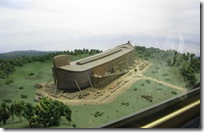 The ark dioramas were one of my favorite sections of the museum because they were spectacular. The ark in the first diorama was probably close to four feet long and the level of detail (in all of them) was just astounding. In fact, the Creation Museum DVD about the ark uses close-ups of these dioramas in their footage and it looks real… like full-sized real. It’s very impressive.
The ark dioramas were one of my favorite sections of the museum because they were spectacular. The ark in the first diorama was probably close to four feet long and the level of detail (in all of them) was just astounding. In fact, the Creation Museum DVD about the ark uses close-ups of these dioramas in their footage and it looks real… like full-sized real. It’s very impressive.
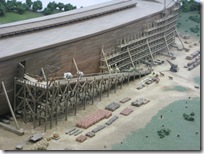 If you look closely in the picture to the right, which is just a close-up of the loading ramp, you’ll notice something interesting following just behind the giraffes. Dinosaurs! The Creation Museum makes it very clear that Noah took dinosaurs onto the ark. They’re very clear that dinosaurs lived with humans. They’re very clear that they really have no concept whatsoever of science… or reality. They are, however, exquisite craftsmen who make awesome dioramas.
If you look closely in the picture to the right, which is just a close-up of the loading ramp, you’ll notice something interesting following just behind the giraffes. Dinosaurs! The Creation Museum makes it very clear that Noah took dinosaurs onto the ark. They’re very clear that dinosaurs lived with humans. They’re very clear that they really have no concept whatsoever of science… or reality. They are, however, exquisite craftsmen who make awesome dioramas.
 A plaque explains about the animals that were loaded onto the ark. They included, of course, dinosaurs, but most of the animals were likely young adults because “Being smaller, they would also be easier to care for.” That would only apply briefly because, since the ark was to be afloat for about a year, most animals would have matured to full size during that time. That bit isn’t mentioned, though.
A plaque explains about the animals that were loaded onto the ark. They included, of course, dinosaurs, but most of the animals were likely young adults because “Being smaller, they would also be easier to care for.” That would only apply briefly because, since the ark was to be afloat for about a year, most animals would have matured to full size during that time. That bit isn’t mentioned, though.
The next diorama showed the ark seaborne as the water rose higher and people were desperate to get on board. Again, the detail was extraordinary… and somewhat disturbing. In the third picture, you can see some competition going on for the top spot (the man holding the rock over his head) and another guy who looks like he’s become the target of a bear’s attention.



After that, however, once all the sinners drowned, things must have gotten somewhat more peaceful.
 Noah and his family (a total of eight) got to hang out in the ark, seemingly in a bit of luxury with fine clothes and plenty of food. It must have been a pleasant cruise from the looks of it. Never mind that eight people had to care for (according to Answers in Genesis, the Creation Museum’s parent company) about 16,000 animals. Never mind that they had to deal with (again, according to AiG) about 12 tons of animal waste each day. Never mind that the ammonia from the rabbit urine alone would be enough to choke a rhino.
Noah and his family (a total of eight) got to hang out in the ark, seemingly in a bit of luxury with fine clothes and plenty of food. It must have been a pleasant cruise from the looks of it. Never mind that eight people had to care for (according to Answers in Genesis, the Creation Museum’s parent company) about 16,000 animals. Never mind that they had to deal with (again, according to AiG) about 12 tons of animal waste each day. Never mind that the ammonia from the rabbit urine alone would be enough to choke a rhino.
The thing is, if you explain the whole ark story by claiming supernatural intervention by God, then there’s really no arguing (other than the whole “God” thing). However, the Creation Museum doesn’t make that claim.
From the AiG page linked above:
While it is possible that God made miraculous provisions for the daily care of these animals, it is not necessary or required by Scripture to appeal to miracles.
They try to show how it’s entirely possible that the flood story was literally true without any significant divine intervention. It’s an absurdist notion.
 Finally, the ark came to rest and the floodwaters began to drain away to… somewhere. This was the final diorama in the ark room, showing the happy ending for Noah and his family. All they had to do from this point is to wait for things to dry out and then go repopulate the planet. Piece of cake.
Finally, the ark came to rest and the floodwaters began to drain away to… somewhere. This was the final diorama in the ark room, showing the happy ending for Noah and his family. All they had to do from this point is to wait for things to dry out and then go repopulate the planet. Piece of cake.
This is also the demarcation point I mentioned at the beginning. The museum was done with the story of the flood and now turned its focus to the aftereffects of the flood. This is where the pseudo-scientific hogwash really takes wing.
 Here’s the sign that sets the stage for what’s to come. The flood caused natural catastrophes like erosion and earthquakes… perhaps the greatest earthquake ever known (sorry… Land of the Lost grabbed hold of me there). They make it clear again that God’s Word, not the past, is the key to everything. Then they go on, ad nauseum, with a vain and scientifically ludicrous attempt to prove their case.
Here’s the sign that sets the stage for what’s to come. The flood caused natural catastrophes like erosion and earthquakes… perhaps the greatest earthquake ever known (sorry… Land of the Lost grabbed hold of me there). They make it clear again that God’s Word, not the past, is the key to everything. Then they go on, ad nauseum, with a vain and scientifically ludicrous attempt to prove their case.
 Starting with the laughable idea that the world’s continents changed from Rodinia to Pangea to their current form in about a year, they show case after case of scientific ignorance. Just for the record, Rodinia is thought to have existed 1,100 and 750 million years ago. Pangea is thought to have existed roughly 300 million years ago. Not so for the Creation Museum. Their claim is that the global flood caused well over 500 million years of plate tectonic shift in about a year… and they’re just getting started.
Starting with the laughable idea that the world’s continents changed from Rodinia to Pangea to their current form in about a year, they show case after case of scientific ignorance. Just for the record, Rodinia is thought to have existed 1,100 and 750 million years ago. Pangea is thought to have existed roughly 300 million years ago. Not so for the Creation Museum. Their claim is that the global flood caused well over 500 million years of plate tectonic shift in about a year… and they’re just getting started.
They try to show how receding floodwaters account for the different geological layers, the corresponding fossil layers, coal deposits, canyons, deserts, mountains, and various other geological features. They fail.



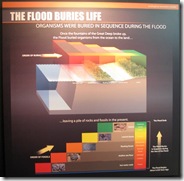


 After showing geological features, they make an attempt to explain how biological development took place. From the evolution of animals (within their “kind,” of course) to the distribution of the animals across all the continents of the world (since Rodinia and Pangea were broken up underwater into separate continents), the explanations are far-fetched at times and hysterically childish at others.
After showing geological features, they make an attempt to explain how biological development took place. From the evolution of animals (within their “kind,” of course) to the distribution of the animals across all the continents of the world (since Rodinia and Pangea were broken up underwater into separate continents), the explanations are far-fetched at times and hysterically childish at others.  Starting with the development of the horse, implying that the “horse” on the ark was just a little guy, it continues with a completely incomprehensible claim about marsupials.
Starting with the development of the horse, implying that the “horse” on the ark was just a little guy, it continues with a completely incomprehensible claim about marsupials.
There are a number of other claims as well, including that Noah only had to have one pair of dogs on board the ark which would have then evolved into all the different canids that we have today, including foxes, wolves, and domestic dogs. That’s a pretty big stretch for a museum that claims to refute the notion of Darwinian Evolution, especially considering that foxes and wolves are completely different species, sharing only a distant common ancestor (as do we all).
One has to wonder, however, how all these different animals spread across the globe so rapidly, especially considering there were so few of them and they supposedly landed high on Mount Ararat. No worries. The Creation Museum folks have got that all figured out, too.
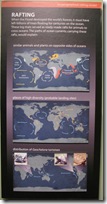 Their explanation is called “rafting.” Here’s the description.
Their explanation is called “rafting.” Here’s the description.
When the flood destroyed the world’s forests, it must have left billions of trees floating for centuries on the ocean. These log mats served as ready-made rafts for animals to cross oceans. The paths of ocean currents, carrying these rafts, would explain: similar animals and plants on opposite sides of the oceans, places of high diversity (probably landing sites), and the distribution of Geochelone tortoises.
 I can’t make that kind of stuff up, but evidently someone has a vivid enough imagination and a low enough self-respect to offer that up as a legitimate hypothesis for the distribution of land animals.
I can’t make that kind of stuff up, but evidently someone has a vivid enough imagination and a low enough self-respect to offer that up as a legitimate hypothesis for the distribution of land animals.
You can read it yourself by enlarging this image to the left.
There’s also a mention of a post-flood ice age, ice cores, the thickening of the Earth’s crust, super volcanoes, super quakes (see! I knew Land of the Lost would factor in here!) and super rapid fossilization due to all the flood-induced catastrophes. It’s worded to sound very science-like, but to anyone with a decent high school education in science, it’s pretty delusional.
 After showing all this “evidence” about the post-flood world, this sign makes the claim that everything is in agreement with the bible. “The more we learn about the Flood and its place in earth history, the more we understand God’s world.” The claim is that the flood explains fossils, rocks, and the “pattern of life.”
After showing all this “evidence” about the post-flood world, this sign makes the claim that everything is in agreement with the bible. “The more we learn about the Flood and its place in earth history, the more we understand God’s world.” The claim is that the flood explains fossils, rocks, and the “pattern of life.”
No. No. No.
It explains none of these things. Every single one of those things is actually a stunning refutation of a biblical global flood. Everything we know about fossils, everything we know about geology, everything we know about the evolution of life… it all shows that our Earth is billions of years old. It does not show, by any rational argument, that the biblical story of Genesis is anything more than a fanciful tale written 2,000 years ago by primitive, tribal humans.
 The next sign, I found to be somewhat ironic. It’s a bible verse from 2 Peter claiming that, in the last days, there will be scoffers. It calls them “willingly ignorant.” If ever there was a better fitting label for creationists in general, and this Creation Museum in particular, I have not heard it. The whole museum screams of willful ignorance… from simple scientific principles to common sense history.
The next sign, I found to be somewhat ironic. It’s a bible verse from 2 Peter claiming that, in the last days, there will be scoffers. It calls them “willingly ignorant.” If ever there was a better fitting label for creationists in general, and this Creation Museum in particular, I have not heard it. The whole museum screams of willful ignorance… from simple scientific principles to common sense history.
 In the next (and last) section, we got to the fourth “C” of “Confusion” which goes into Babel and the splitting of human languages and related issues. I was far too weary at that point to deal with it. At the end, however, it showed a sign telling how human religion came to be when people starting “worshipping the creation rather than the Creator… blah, blah, blah.”
In the next (and last) section, we got to the fourth “C” of “Confusion” which goes into Babel and the splitting of human languages and related issues. I was far too weary at that point to deal with it. At the end, however, it showed a sign telling how human religion came to be when people starting “worshipping the creation rather than the Creator… blah, blah, blah.”
For people who believe all this, the end of the tour probably leaves them feeling inspired and feeling as though their faith has been strengthened. For me, since I have enough science knowledge to know that it’s all bunk, it left me feeling tired… battered… assaulted… profaned… contaminated… and sad.
It’s sad that so many people maintain that incredibly high level of willful ignorance. It’s sad that they let their lives be governed by ancient folklore. It’s very sad that they indoctrinate their children with the same baseless beliefs… and the same horribly detrimental misunderstanding of basic science and our world.
The final three “C’s” were jammed together at the end with a video titled The Last Adam… about Jesus and his death on the cross and resurrection. It was a somewhat bloody video and, like the rest of the museum videos, was of an extremely high production value. Also like the rest of the museum, it put in the information that supported its case and left out the information that didn’t.
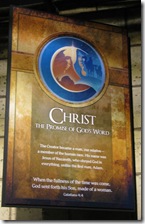
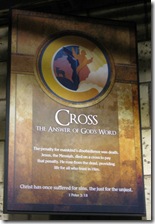

I omitted a special exhibit in an earlier post that I’ll touch on in the next post. It was titled “Natural Selection is Not Evolution” and was packed full of creationist claims that have been debunked and disproven for years and years… just more intellectual dishonesty.
But that, it seems, is what the Creation Museum is all about.
(the tour will continue in part 6)
 At the end of the Creation Museum’s “Walk Through History,” they show a video, The Last Adam, that encompasses their final three C’s of History… Christ, Cross, and Consummation. If you’ve read my six-part write-up of the museum, you’ll understand that, by this time, I was worn out from keeping myself from bursting out with ridiculing laughter or derisive criticisms of the museums disturbingly shoddy “science.” So, in a way, it was nice to just sit in a dark room to passively watch a video instead of walking the halls and reading ridiculous plaques that bastardized science.
At the end of the Creation Museum’s “Walk Through History,” they show a video, The Last Adam, that encompasses their final three C’s of History… Christ, Cross, and Consummation. If you’ve read my six-part write-up of the museum, you’ll understand that, by this time, I was worn out from keeping myself from bursting out with ridiculing laughter or derisive criticisms of the museums disturbingly shoddy “science.” So, in a way, it was nice to just sit in a dark room to passively watch a video instead of walking the halls and reading ridiculous plaques that bastardized science. The video is structured so that it brings up things that were seen earlier in the museum… the paleontologist, the dinosaurs, Adam, sin, death, etc. Bible verses are displayed and quoted throughout as the narration continues. The main point of the video is, of course, that Jesus came to Earth to die for our sins, cleaning up the unholy mess the “first” Adam created 4,000 years before… when T-Rexes were vegetarians.
The video is structured so that it brings up things that were seen earlier in the museum… the paleontologist, the dinosaurs, Adam, sin, death, etc. Bible verses are displayed and quoted throughout as the narration continues. The main point of the video is, of course, that Jesus came to Earth to die for our sins, cleaning up the unholy mess the “first” Adam created 4,000 years before… when T-Rexes were vegetarians. There’s also a testimony of a Roman Centurion who was there when Jesus was crucified (“Actual Footage” as Penn and Teller would say) talking about how Jesus said, “Forgive them father. They don’t know what they’re doing” and then said “It is finished” and then died. Strangely, there was no mention of Matthew and Mark saying that Jesus also said, “Father, why have you forsaken me?” I guess that didn’t fit into the whole “God’s Plan” scenario they were trying to convey.
There’s also a testimony of a Roman Centurion who was there when Jesus was crucified (“Actual Footage” as Penn and Teller would say) talking about how Jesus said, “Forgive them father. They don’t know what they’re doing” and then said “It is finished” and then died. Strangely, there was no mention of Matthew and Mark saying that Jesus also said, “Father, why have you forsaken me?” I guess that didn’t fit into the whole “God’s Plan” scenario they were trying to convey. Now, I’m not squeamish, but this is a “family museum” and there are little kids watching this. It’s appalling. Not only is the blood and gore inappropriate for young children. It’s a horrifying thing to show this to children and then tell them that they must worship this god and revere this religion that so glorifies blood and death.
Now, I’m not squeamish, but this is a “family museum” and there are little kids watching this. It’s appalling. Not only is the blood and gore inappropriate for young children. It’s a horrifying thing to show this to children and then tell them that they must worship this god and revere this religion that so glorifies blood and death.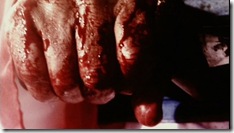 If the museum is trying to show the greatness of the Christian religion, they’re failing. What they do with this video, however, is portray the death cult mentality that this religion so vehemently embraces. It’s a very high production value synopsis of Christianity: create a problem and then offer a solution, but make sure there’s lots of blood, suffering, and death.
If the museum is trying to show the greatness of the Christian religion, they’re failing. What they do with this video, however, is portray the death cult mentality that this religion so vehemently embraces. It’s a very high production value synopsis of Christianity: create a problem and then offer a solution, but make sure there’s lots of blood, suffering, and death. That sounds like scapegoating to me. In the bible, God created everything and set Adam up to fail, knowing that he would fail and “screw up” this “perfect” creation. That’s not perfect by any stretch of the imagination unless you’re a pulp crime fiction author. The whole paragraph is just absurd when you consider Christian theology.
That sounds like scapegoating to me. In the bible, God created everything and set Adam up to fail, knowing that he would fail and “screw up” this “perfect” creation. That’s not perfect by any stretch of the imagination unless you’re a pulp crime fiction author. The whole paragraph is just absurd when you consider Christian theology.
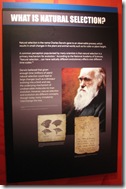


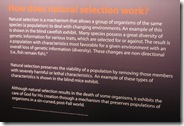



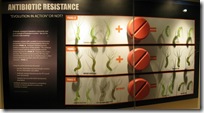
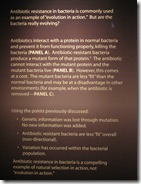
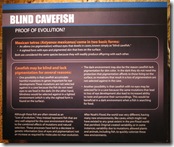


































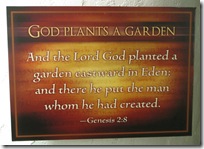









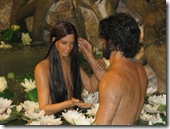










 As I’m sure you are aware, some Christians interpret the bible mostly as a fictional story filled with allegories and examples showing how we should live our lives. Some other Christians seem to not “interpret” the bible at all, instead taking it at its literal word, insisting that everything is true in exactly the way it is written.
As I’m sure you are aware, some Christians interpret the bible mostly as a fictional story filled with allegories and examples showing how we should live our lives. Some other Christians seem to not “interpret” the bible at all, instead taking it at its literal word, insisting that everything is true in exactly the way it is written.